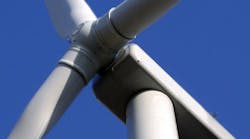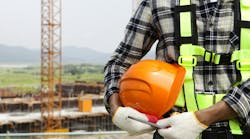The first quarter of 2011 saw more than 1,100MW of wind power capacity installed — more than double the capacity installed in the first quarter of 2010, according to the American Wind Energy Association (AWEA). With this infrastructure growth comes a wealth of new jobs for wind turbine technicians — and responsibility for wind energy employers to protect them from job-site hazards.
Workers who erect and maintain wind turbines are inevitably exposed to fall hazards, given the fact that a typical wind turbine can reach up to 100 ft tall. According to OSHA’s construction industry Subpart M (§1926.500) fall protection standard, workers must be protected from all fall exposures of
6 ft or greater. OSHA has different fall protection requirements for construction (installation of towers) and general industry (maintenance).
According to OSHA, during installation, workers may need to access individual turbine sections to weld/fit individual sections together, run electrical or other lines, and install/test equipment, often at heights greater than 100 ft. Construction workers on wind farms when exposed to fall distances of 6 ft or more must be protected from falls by using one of the following methods: guardrail systems (www.osha.gov/SLTC/etools/construction/falls/guardrail.html), safety net systems (www.osha.gov/SLTC/etools/construction/falls/safetynet.html), or personal fall arrest systems (www.osha.gov/SLTC/etools/construction/falls/fallarrest.html). Workers must also inspect their equipment on a daily basis. According to AWEA, a more thorough inspection must be performed and documented on a quarterly basis — and any damaged equipment must be taken out of service immediately.
Maintenance work involving wind turbines is generally considered by OSHA to fall under its general industry (1910) standards. Such workers when exposed to fall hazards of 4 ft or more must be protected by a standard railing. If such a railing is not possible, then the workers must be protected from falls through the use of personal protective equipment (PPE), such as a personal fall arrest system or a safety net. General industry workers engaged in maintenance of wind turbines may have to climb up the towers using fixed ladders. While climbing a fixed ladder that exceeds 20 ft in length, a ladder equipped with a cage, well, or ladder safety device must have a landing platform every 30 ft; a ladder not so equipped must have a landing platform every 20 ft. For more information, read OSHA’s “QuickCard on Fall Protection” at: www.osha.gov/Publications/fall_protection_qc.pdf or review its hazards and possible solutions at: www.osha.gov/SLTC/fallprotection/index.html#recognition and https://www.osha.gov/SLTC/fallprotection/construction.html. In addition, OSHA 1910.269 (electrical transmission & distribution) can also come into play, which has its own set of requirements.
General Climbing Safe Work Practices
- Maintain 100% tie-off at all times when exposed to a fall distance of or greater than 6 ft, using a properly installed fall arrest device.
- A climber’s hands, gloves, and shoes must be free of mud, grease, or other slippery foreign substances prior to climbing.
- All tools/parts must be secured to an employee’s body with a lanyard, stored in a closable pocket, or carried in a closable bag.
- Never position or climb within the fall distance of a climber above. This fall distance will vary depending on the fall arrest equipment being used and must be continuously evaluated by both climbers.
- Rest regularly while climbing.
- Do not use safety climb system as a resting device; rest at turbine platforms or use a positioning lanyard while resting.
- Whenever possible, ground personnel should remain clear of the tower during all climbing activities. If ground personnel must work near the base of a tower while climbing occurs, they must remain continuously aware of hazards overhead.
- A trained employee is the final component of a personal fall arrest system (PFAS). No employees should be permitted or required to use a PFAS unless they have been thoroughly trained in fall hazards, as well as the use, inspection, maintenance, and limitations of the system.
Reprinted with permission from “Safety in Wind Energy – Fall Protection,” American Wind Energy Association
Turbine Climbing Safe Work Practices
- Climb tower only when turbine is in the “off” position, unless otherwise trained and authorized by the site safety manager or operations and maintenance representative.
- Climbers should close platform doors after passing through them.
- Correct or report any loose parts found on a tower or nacelle.
- The first person to climb the tower ladder should wipe any grease or oil from the ladder or climbing surfaces.
- If turbine elevators or climbing assistance devices are to be used, follow all safety instructions and rules given by the equipment manufacturer, turbine manufacturer, and site staff.
Reprinted with permission from “Safety in Wind Energy – Fall Protection,” American Wind Energy Association
PRODUCTS
RFID system for fall protection equipment
The i-Safe 3.0 Intelligent Safety System is a significant upgrade to the company’s existing i-Safe 2.0 system, which was launched in 2006. According to the company, i-Safe became the first radio frequency identification (RFID) system dedicated to fall protection equipment and inspection tracking. Key system upgrades to the 3.0 product include: multiple software offerings; customizable products; consistent inspection tracking; effective asset management; versatile management reports, inspection scheduling and trigger alerts; and the ability to use high-frequency RFID tags or barcode information capture. Capital SafetyHarness
The Raven Platinum Series Harness is designed for the worker who lives in his harness, according to the company. This product features lightweight hardware for less fatigue, breathable padding, pull-down shoulder adjusters, and 70° D-rings at back and on hips. It also offers users quick connect buckles on chest and legs, a new and comfortable 5-in. padded backpad, and a carry-all bag.Elk River
Tower climber harness
Meeting or exceeding all applicable fall-arrest systems standards, including OSHA, ANSI, and the stringent ANSI Z359, the FrenchCreek 897ABT Tower Climber Harness offers a Custom-Fit Climber with an 8-point adjustment system; EZ-Slide back D-ring; chest strap with easy-to-use pass-thru buckles; spring-loaded friction buckles on shoulder straps for easy adjustment; tongue buckle leg straps; pass-thru buckle adjustable front center chest D-ring for vertical climbing systems; and shoulder pads for comfort when carrying maximum tool weight. The product’s removable tongue-buckle tool belt, reinforced for rigidity, can be easily installed to accommodate any configuration of tool pouch.FrenchCreek Production
Full body harness
According to the company, the Cyclone full body harness offers users an industry-first shoulder adjustment feature for an extremely comfortable fit. This product can be used for ascending a ladder inside wind turbines. Designed with the unique X-back, which leaves the harness straps tangle free, this harness is suitable for fall arrest, work positioning, rescue, and rope access applications. Featuring single-hand adjustment, this product is made from top-grade corrosion-resistant steel. An aesthetic stitch pattern enhances stitching strength, and Lateral D-rings with knitted mesh pads are specifically bent for extra comfort while working.Guardian Fall Protection








